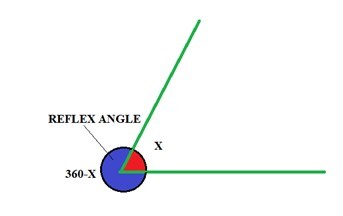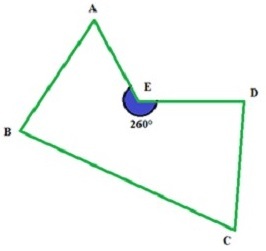
 Data Structure
Data Structure Networking
Networking RDBMS
RDBMS Operating System
Operating System Java
Java MS Excel
MS Excel iOS
iOS HTML
HTML CSS
CSS Android
Android Python
Python C Programming
C Programming C++
C++ C#
C# MongoDB
MongoDB MySQL
MySQL Javascript
Javascript PHP
PHPPhysics
Chemistry
Biology
Mathematics
English
Economics
Psychology
Social Studies
Fashion Studies
Legal Studies
- Selected Reading
- UPSC IAS Exams Notes
- Developer's Best Practices
- Questions and Answers
- Effective Resume Writing
- HR Interview Questions
- Computer Glossary
- Who is Who
Reflex Angle
Introduction
An angle is a degree of rotation between two intersecting lines. Angles can be of various types such as, acute angle, right angle, obtuse angle, and others. One of such angles are reflex angles. Reflex angles are angles which are a reflection of the angle between two lines. Because we cannot measure an angle greater than 180° with the help of a protractor, we can measure the angle with the help of a reflex angle. In this tutorial, we will learn about angle, type of angles, reflex angles, concave polygon, reflex angles in real life, and some solved examples based on reflex angles.
Angles
An angle is defined as a degree of rotation between two lines or rays in a two-dimensional geometry. An angle can also be defined as the variation in degrees formed between two rays emanating from the same point.
Types of Angles
Angles can be divided into categories depending on their sizes.
Acute angle − An angle is said to be an acute angle if two lines intersect each other and form an angle which is less than 90 degrees.
Right angle − An angle is said to be a right angle, if the two lines intersect each other at 90 degrees angle.
Obtuse angle − If two lines intersect each other at an angle greater than 90 degrees, then the angle is said to be an obtuse angle.
Straight angle − If two lines intersect each other at an angle equal to 180 degrees, the angle subtended is called straight angle.
Reflex angle − If two lines intersect each other at an angle greater than 180 degrees and lesser than 360 degrees, then the angle is said to be reflex angle.
Complete angle − If two lines intersect each other at an angle equal to 360 degrees, then the angle is said to be complete angle.
Reflex Angles
A reflex angle is an angle between two lines which is a reflection of the main angle. A reflex angle can have a degree of rotation between 180° and 360°. An angle along with its reflex angle form a complete angle. As we know that a complete angle is 360°, for an angle x the corresponding reflex angle would be 360-x.
A reflex is given in the diagram below. The diagram shows an angle between two lines and the reflex angle corresponding to it, which when combined form a complete angle. A reflex angle helps us in determining angle which are greater than 180°.

For finding a reflex angle, when an angle x is given, we can subtract angle x from 360°.
Let the given angle be x as given in the diagram.
We know that a complete angle measures 360°.
So, the reflex angle= 360°-x
Concave Polygons
A polygon that has one or more interior angles which is greater than 180° is called a concave polygon.
A concave polygon has at least four sides, and it cannot be a regular polygon.
A convex polygon, on the other hand is a polygon which has all its angles than 180°. Therefore, a concave polygon is opposite to a convex polygon.
As shown in the figure of a polygon one of the angles is 260°, which is greater than 180°.

Reflex Angles In Real Life
Reflex angles can be seen in our daily life everywhere just like angles. Because we can see angles everywhere there has to be reflex angles associated with angles. Some of the examples are −
Clock − An analog clock is one of the best examples of a reflex angle because we see it everyday and everywhere. Suppose a clock is striking 3, we know that the hour needle and the minute needle make a 90° angle. Thus the digits between that angle will be 1, 2, and 3. Whereas if we look for the reflex angle, the angle will include digits 4, 5 ,6 ,7 ,8 ,9, 10, 11, and 12.
Pizza − If you see a pizza, it's a circular shape. When we cut pizza into pieces along its centre and take a piece out of it, the empty space forms an angle, while the remaining pizza shows its reflex angle.
Solved Examples
1.For an angle $\mathrm{\angle AOB== 57^\circ}$, find the value of reflex angle $\mathrm{\angle AOB}$.
Solution: As we know that the angle and its reflex angle collectively make a complete angle. Therefore, the reflex angle can be calculated by
$$\mathrm{\angle AOB = 360^\circ - 57^\circ = 303^\circ.}$$
2.State true or false for a reflex angle using its properties.
A reflex angle can be an obtuse angle.
170° is a reflex angle.
A reflex angle can be a complete angle
Solution:
No, an obtuse angle is less than 180°, whereas a reflex angle should be greater than 180°.
False, 170° is not a reflex angle, because it is an obtuse angle.
A reflex angle cannot be a complete angle because a complete angle is 360° and a reflex angle is less than 360°.
3.Give examples of reflex angles.
Solution:
As we know a reflex angle is between 180° and 360°
Therefore, if we add an acute angle, a right angle or an obtuse angle to a straight angle it gives the reflex angle.
Conclusion
An angle is a degree of rotation between two intersecting lines. Angles can be of various types such as, acute angle, right angle, obtuse angle, and others. One of such angles are reflex angles. A reflex angle is an angle between two lines which is a reflection of the main angle. A reflex angle can have a degree of rotation between 180° and 360°. A polygon that has one or more interior angles which is greater than 180° is called a concave polygon. A convex polygon, on the other hand, is a polygon which has all its angles less than 180°. An analog clock is one of the best examples of a reflex angle. When we cut pizza into pieces along its centre, the remaining pizza shows its reflex angle.
| Type of angle | Description |
|---|---|
| Acute angle | Angle which are less than 90° |
| Right angle | Angle which is equal to 90° |
| Obtuse angle | Angle which is greater than 90° |
| Straight angle | Angle which is equal to 180° |
| Reflex angle | Angle between 180° and 360°. |
| Complete angle | Angle which is equal to 360°. |
FAQs
1. What are some examples of reflex angles?
200°, 225°, 270°, and 315° are some of the reflex angles.
2. What is a convex polygon?
A convex polygon is a polygon with all of its interior angles less than 180°.
3. What is a concave polygon?
A concave polygon is a polygon which has at least one of its angles greater than 180°.
4. How is a reflex different from a primary angle?
A primary angle cannot be greater than 180°, whereas a reflex angle is always greater than 180°.
5. What is the formula for finding a reflex angle?
A reflex angle can be obtained by subtracting the primary angle from 360°.

